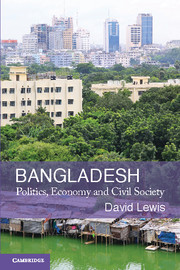Book contents
- Frontmatter
- Contents
- Maps
- Abbreviations
- Acknowledgements
- 1 Introduction
- 2 A State in the Making
- 3 Towards Bangladesh
- 4 State, Politics and Institutions
- 5 Nongovernmental Actors and Civil Society
- 6 Economic Development and Transformation
- 7 Population, Natural Resources and Environment
- 8 Conclusion
- Glossary of Bengali Terms
- Bibliography
- Index
7 - Population, Natural Resources and Environment
Published online by Cambridge University Press: 05 June 2012
- Frontmatter
- Contents
- Maps
- Abbreviations
- Acknowledgements
- 1 Introduction
- 2 A State in the Making
- 3 Towards Bangladesh
- 4 State, Politics and Institutions
- 5 Nongovernmental Actors and Civil Society
- 6 Economic Development and Transformation
- 7 Population, Natural Resources and Environment
- 8 Conclusion
- Glossary of Bengali Terms
- Bibliography
- Index
Summary
This chapter examines the relationship between political and economic change, and broader demographic and environmental factors. It begins with a discussion of Bangladesh's ecological setting. The country's location within a highly fertile but ecologically unstable river-delta system is central to an understanding of its population and economy. As we saw in Chapter 6, agricultural production has increased since the 1980s through the spread of modern farming techniques and the rapid expansion of irri-gation technology, but production gains have come at the expense of heavy environmental costs. These include the depletion of soil quality through the overuse of artificial fertilisers, increased pollution from the use of chemical pesticides, the problem of saline intrusion and, in some areas, the contamination of groundwater and crops by arsenic, natural deposits of which have been disturbed by the drilling of new irrigation wells.
The next part of the chapter then moves on to a discussion of population issues. The delta has long attracted large numbers of people who come to farm its small areas of highly fertile land, leading to longstanding concerns about “population pressure” as a negative factor that affects development. Bangladesh is a country not much larger in area than England, but it now faces a population that is estimated at 162 million, and is one of the most densely populated areas in the world. For example, although Bangladesh has historically been a country of small farmers, population pressure on available cultivable land combined with long-term land fragmentation through inheritance practices means that more than half of the rural population has been functionally landless for the past few decades. The idea that high levels of population growth need to be brought down has long been an important priority among government policy makers and international development agencies. Yet people nevertheless remain one of the country's key resources.
- Type
- Chapter
- Information
- BangladeshPolitics, Economy and Civil Society, pp. 167 - 196Publisher: Cambridge University PressPrint publication year: 2011
- 1
- Cited by



